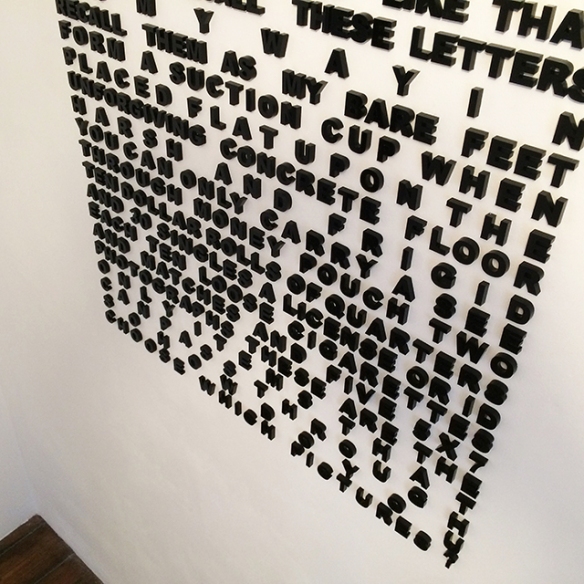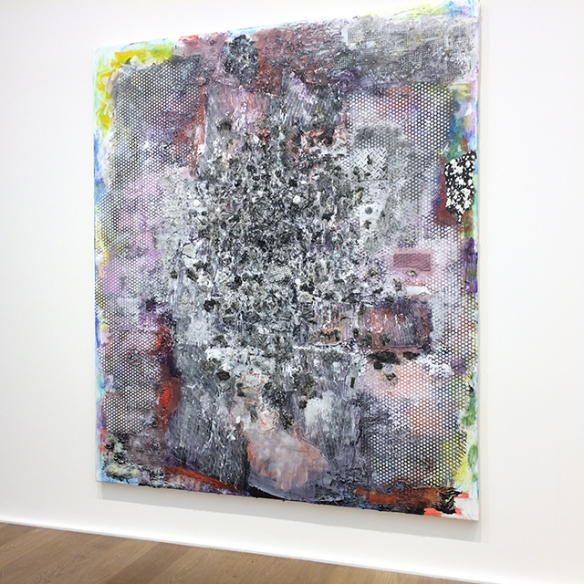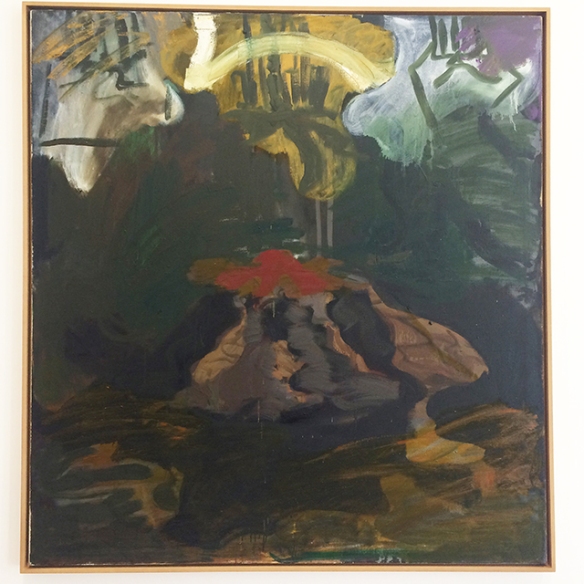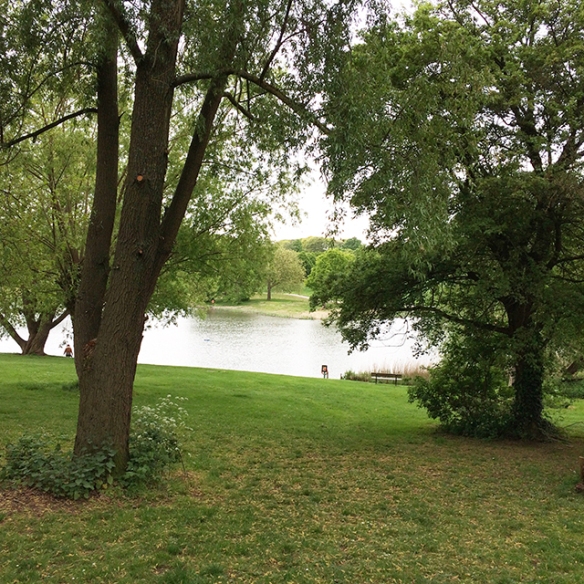With a lap round The Serpentine in Hyde Park taking the time up to ten o’clock, the first gallery of today’s run should now be open. But alas, my check of opening times on the internet last night was not done accurately enough and it turns out the gallery is in fact closed today for refurbishments. Fortunately one of their artists, Sanford Biggers, is showing just a few hundred metres away at Phillips auction house. The good fortune of spotting the gallery artist in this alternative venue is further enhanced by the quality of the work. It comprises a delicately stitched, embroidered quilt cover with a back story that it was donated to the artist along with many others from families whose ancestors were effected by slavery. This has become part of the rich historical narrative of the artwork itself.
A few blocks along in Victoria Miro, Stan Douglas is displaying photographic-based work. Although primarily the show focuses on high-resolution photographic reconstructions of the London riots of 2011, there are also two abstract works. These additional abstract works are fascinating because they are actually based on simple jpeg images of geometric shapes but where the information of the original digital files has been altered in a systematic way. The resulting rhythmic patterns, we are told, reveal the wave patterns that make up the structure of all jpeg files.
Nearby in the hub of galleries close to the Royal Academy, Pace Gallery is showing some of the American Abstract Expressionists. The dominant figure in this group, at least from an historic perspective, is Kenneth Noland, and the show builds on this popularity by also including works from other important artists from that movement including Frank Bowling and Sam Gilliam. The former has poured paint down the canvas and despite the absence of a brush, has created an elegant and ordered painted surface, evidenced by the clean boarders on either side of a main channel that comprises a complex multi-layered surface of paint. Meanwhile, the latter artist has removed his canvases from their stretchers altogether. They have been bunched up into a few hanging points and suspended from the gallery walls.
The London art scene is buzzing right now with the Basquiet show at the Barbican. Today’s run actually takes in a concurrent show in the building’s second gallery, known as The Curve. John Akomfrah has collected a multitude of chemical containers with their coloured residues still visible in white plastic grooves. He has then suspended them from the ceiling where they mingle with the lighting to create a stunning spectacle of glowing white plastic. The artwork actually references the anthropocene, an emerging name for Earth’s most recent age, and one that is characterised by human influence rather than geological change. On this account, the artwork draws more attention, in fact, to the pollution of these chemical containers than to their sublime beauty. Perhaps also on this solemn note, it is where today’s blog comes to a close, though the run itself would take in David Blandy at Seventeen, Omar Ba at Hales Gallery, Alan Belcher at Greengrassi and Abel Auer at Corvi Mora, all offering great exhibitions over the rest of the day.
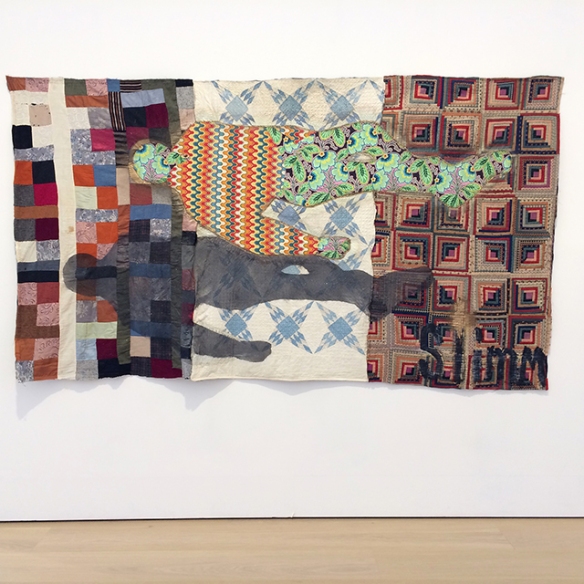
Sanford Biggers of Massimo De Carlo on show, and for auction, at Phillips.

Stan Douglas at Victoria Miro with a manipulation of a jpeg file. These familiar digital files, used for storing images, use clever techniques to compress them and the artist has intervened in some way to produce an image that reveals this underlying technique as an image of its own.

Frank Bowling often represented in London by Hales Gallery on show here at Pace Gallery.

Sam Gilliam at Pace Gallery with a detached canvas.

John Akomfrah represented by Lisson Gallery showing at Barbican. These are chemical containers that the artist has used to represent, with some beauty, the Anthropocene, our current geological time period by some accounts.

David Blandy of Seventeen Gallery with a digital reconstruction of the solar system.
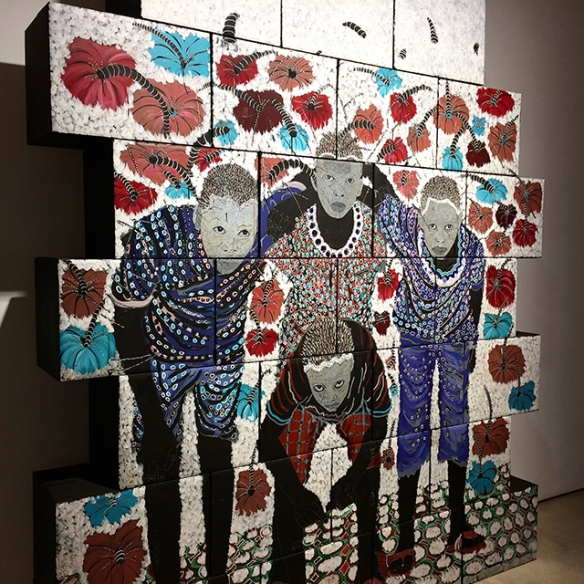
Omar Ba of Hales Gallery draws on the experiences of his native Senegal to develop his rich symbolic language in paintings.

Alan Belcher at Greengrassi with paintings of geometric objects that accompany, in his show, paintings of ducks, fish and shellfish each having a surreal quality.

Abel Auer of Corvi Mora.
 Richard Artschwager at Gagosian !!!
Richard Artschwager at Gagosian !!! Alex Katz at Timothy Taylor.
Alex Katz at Timothy Taylor. Ruth Asawa at David Zwirner. She studied at Black Mountain College and developed these intricately woven sculptures.
Ruth Asawa at David Zwirner. She studied at Black Mountain College and developed these intricately woven sculptures. Benode Behari Mukherjee at David Zwirner with drawings and collages made after he went blind in the late 50’s.
Benode Behari Mukherjee at David Zwirner with drawings and collages made after he went blind in the late 50’s. Leake Street.
Leake Street. Adam Buick at Corvi Mora as part of Condo Art.
Adam Buick at Corvi Mora as part of Condo Art. Juha Pekka Matias Laakkonen at Corvi Mora with a woven rope floor sculpture.
Juha Pekka Matias Laakkonen at Corvi Mora with a woven rope floor sculpture. Pae White at Corvi Mora with a vivid. Embroidered, fabric artwork.
Pae White at Corvi Mora with a vivid. Embroidered, fabric artwork. Ellen Gronemeyer at Greengrassi with delicate paintings.
Ellen Gronemeyer at Greengrassi with delicate paintings.
 The Old Kent Road tank has had a new paint job. Photographed at the beginning of today’s run. Thank you @julianlowepaintings for telling me about the new paint job.
The Old Kent Road tank has had a new paint job. Photographed at the beginning of today’s run. Thank you @julianlowepaintings for telling me about the new paint job. Egg-shaped sculpture by the River Lee. Who is the artist?
Egg-shaped sculpture by the River Lee. Who is the artist? Ed Baynard at Stephen Friedman Gallery with stylised still-lifes.
Ed Baynard at Stephen Friedman Gallery with stylised still-lifes. Jessi Reaves at Herald Street with re-purposed household items elevated to high art.
Jessi Reaves at Herald Street with re-purposed household items elevated to high art. Bruce Conner at Thomas Dane Gallery with rapidly changing images, some forming coherent sequences others seemingly random.
Bruce Conner at Thomas Dane Gallery with rapidly changing images, some forming coherent sequences others seemingly random. Ana Jotta at Greengrassi with intriguing combinations of objects that also have a theatrical feel to them.
Ana Jotta at Greengrassi with intriguing combinations of objects that also have a theatrical feel to them. Glenn Sorensen of Corvi Mora with images that seem like glimpses of nature.
Glenn Sorensen of Corvi Mora with images that seem like glimpses of nature. Chris Gilvan Cartwright at Bloomberg New Contempories.
Chris Gilvan Cartwright at Bloomberg New Contempories. Xiuching Tsay at Bloomberg New Contempories.
Xiuching Tsay at Bloomberg New Contempories. Marylyn Molisso at Tension Fine Art.
Marylyn Molisso at Tension Fine Art. Street art meets canal boat on Islington stretch of Regent’s Canal.
Street art meets canal boat on Islington stretch of Regent’s Canal. On the water near Kings Cross, propane tanks aglow.
On the water near Kings Cross, propane tanks aglow. Laure Prouvost at Lisson Gallery with text on a corner.
Laure Prouvost at Lisson Gallery with text on a corner. Faith Ringgold at Serpentine Gallery with poignant painted canvases integrated into stitched, quilted, borders.
Faith Ringgold at Serpentine Gallery with poignant painted canvases integrated into stitched, quilted, borders. Faith Ringgold at Serpentine Gallery with paintings showing powerful narratives. A burning ship and its trade are the very symbols of injustice.
Faith Ringgold at Serpentine Gallery with paintings showing powerful narratives. A burning ship and its trade are the very symbols of injustice. Faith Ringgold holds court and all of our attention at Serpentine Gallery today as she discusses her work there.
Faith Ringgold holds court and all of our attention at Serpentine Gallery today as she discusses her work there. Shelagh Cluett at Greengrassi with delicate, sea-creature-like sculptures.
Shelagh Cluett at Greengrassi with delicate, sea-creature-like sculptures. David Lieske at Corvi Mora.
David Lieske at Corvi Mora.








 Serpentine Gallery, best of.
Serpentine Gallery, best of. Frieze, best of.
Frieze, best of. 
















